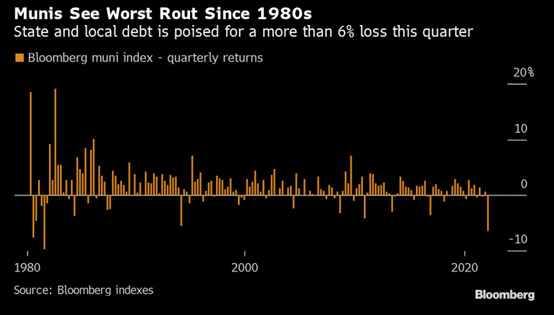AmeriVet Weekly Muni Snapshot

|
Municipal New Issuance: The final week of the first quarter of 2022 had a total negotiated volume of just under $7 billion with just one deal over $1 billion which was the California State Health Facilities Authority, which issued taxable bonds. AmeriVet was a Selling-Group-Member in the second largest deal, which was the $950 million New York City Transitional Finance Authority. AmeriVet was also in one other deal for the week which was the $227 million University of Connecticut issuance. With the large cuts in MMD this week, many issuers had to make adjustments to their initial pricing to make their bonds more marketable. We also saw Washington University issue $1 billion in taxable bonds and the University of Miami issue $500 million in taxable bonds with both using a corporate cusip. Municipal Secondary Trading: We continue to see volatility in the markets as secondary trading has picked up from the prior week of $40 billion in secondary trading to $44 billion last week. Clients continue to place high amounts of their bonds up for the bid. According to Bloomberg, clients put up over $6.1 billion of their bonds for the bid last week with four of those days having over $1 billion in bids-wanted. |
 |
|
Municipal Spread: Municipals for the final week of March continued their struggle for the year as yields continue to rise with 10-year bonds rising by 2.4 basis points to 2.23% as concerns about inflation, the Feds response, and fears of a recession are keeping spreads softer in the near term. Municipal Bonds continue to struggle compared to Treasuries as state and local debt maturing in 10 years is now yielding 94% compared to the previous week when those ratios were at 89.3% and 90.3% a month ago. The thirty-year bonds are now yielding 107.16% of Treasuries, the highest since late 2020, those same ratios hit a low of 67% back in June 2021. We continue to see the Municipal Bond curve flatten as the gap between sort-term and long-term bonds flatten by 5.8 basis points to 81 basis points. |
 |
|
For the seventh straight week, investors pulled money out of municipal-bond mutual funds to the sum of about $2 billion in the week that ended Wednesday according to Refinitiv Lipper US Fund Flows data. This follows the prior weeks $1.5 billion loss as well. Municipal funds have lost roughly $21 billion in funds year-to-date. On the flip side, Municipal ETFs raked in $4.5 billion of inflows the first quarter of 2022 despite municipal bond markets having its worst quarter in over 40 years. |
|
Municipal Bonds closed out its worst quarter in over 40 years with a loss of about 6.3%, a rare pullback for an asset class that investors usually favor for stability. Although, we did see a loss so far for the year, it is still in line with other fixed income bonds as US Treasuries is down about 5.9% and US corporates are down 7.7%. March alone had a loss of 3.24%, which is close to the losses we saw back in March of 2020 where we saw a loss of 3.24%. These losses continue to mount as central banks look to combat inflation which has been growing the fastest in decades. The first quarter has seen Municipal Bond market lose about $108 billion of market value, prompting outflows from mutual funds and intense selling pressure in the secondary market. With interest rates higher by about 100 basis points from a year ago, coupled with improved credit conditions, we should start to see Municipal Bonds become appealing to investors again. |
 |
|
Municipal Supply :The first week of April will have a robust calendar with $10 billion in expected volume with three issues being over $1billion in size. The New York Transportation Development Corporation will be issuing $1.3 billion in tax-exempt bonds for Terminal 4 John F. Kennedy International Airport Project. The Dallas Fort Worth International Airport will be issuing $1.2 billion in taxable bonds. The Triborough Bridge and Tunnel will be issuing $1 billion in refunding bonds. AmeriVet will be in two issues this week as a Selling-Group-Member, which will be the $626 million Power Authority of the State of New York, as well as the $85 million State of Oregon Housing and Community Services Department. |
 |



